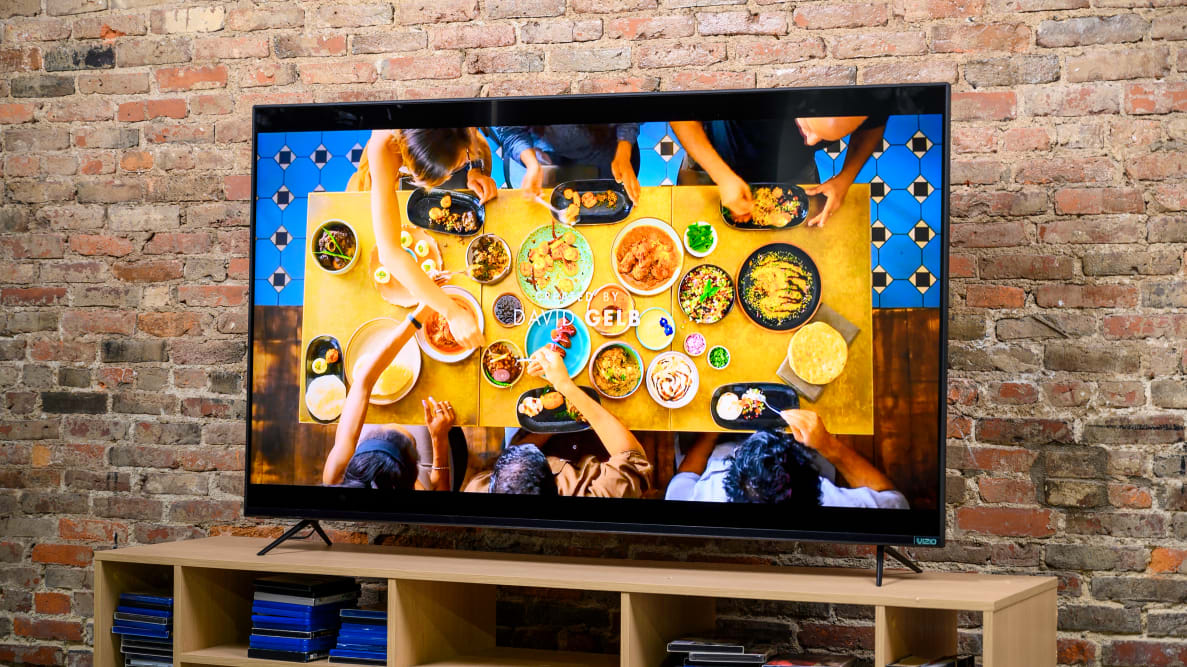Pros
-
Great price
-
Excellent contrast
-
Tons of color
Cons
-
Forgettable design
-
Finicky features
-
Not as bright as competition
For the last several years, Vizio's M-Series has been a mainstay of TV value-hunters. The M-Series TVs (much like TCL's 6-Series) tend to give users the latest TV technology at much more affordable prices than the competition.
To that end, 2019's M-Series Quantum delivers 4K resolution, an LED backlight with full-array local dimming technology, smart features, HDR and Dolby Vision compatibility, and—as you might have guessed from the name—quantum dots. Quantum dots are a newer TV tech that provide a big boost to a TV's color capabilities, and for the last several years they've really only been available in very high-end TVs from brands like Samsung and Sony. With the M-Series Quantum, Vizio is making this technology available to people who might not have $2,000 to spend on a new TV.
Are the M-Series Quantum TVs perfect specimens? No—Vizio's learned how to cut just enough corners that, while nothing about them is too egregious, they're not as buttoned-up and posh-looking as their higher-price counterparts. Picture quality is the strongest foot forward here, while the design is nothing to speak of and elements of their software and behavior can be a bit frustrating. But if you don't need the fanciest-looking TV in the neighborhood and just want to get your hands on good, affordable performance, you should check these TVs out.
About the Vizio M-Series Quantum (2019)
Vizio's 2019 M-Series Quantum TV series is available in multiple screen sizes (and in some cases, more than one of a single screen size):
- 43-inch (Vizio M437-G0), MSRP $349 — 400 nits, 16 local dimming zones
- 50-inch (Vizio M507-G1), MSRP $449 — 400 nits, 16 local dimming zones
- 55-inch (Vizio M557-G0), MSRP $699 — 400 nits, 16 local dimming zones
- 55-inch (Vizio M558-G1), MSRP $549 — 600 nits, 90 local dimming zones
- 65-inch (Vizio M657-G0), MSRP $699 — 400 nits, 20 local dimming zones
- 50-inch (Vizio RED M507RED-G1), MSRP $479 — brightness/zone count not listed
- 65-inch (Vizio M656-G4), MSRP $699 – 400 nits, 12 local dimming zones
- 55-inch (Vizio M556-G4), MSRP $499 — 400 nits, 10 local dimming zones
- 70-inch (Vizio M706-G3), MSRP $899 — 400 nits, 12 local dimming zones
- 65-inch (Vizio M658-G1), MSRP $749 — 600 nits, 90 local dimming zones
As you can see, the availability is a little confusing. The M-Series Quantum TVs are available in varying production runs from "G0" to "G4," and while most of them have between 10 and 16 local dimming zones, some have a lot more. The pricing is also a bit confusing: why is the brighter 55-inch with 90 local dimming zones more affordable than the 400 nit version with 16 local dimming zones? The world may never know.
With just about any LCD TV, you want as many local dimming zones as you can get. For that reason we'd recommend focusing on the two M-Series TVs with 90 zones—the 55-inch Vizio M558-G1 and the 65-inch Vizio M658-G1. All the Vizio M Series Quantum TVs should be great, but those should be the best for most people.

From a design perspective, the M-Series Quantum isn't going to win any awards, but its picture quality rocks.
While brightness and local dimming zone count vary from model to model, a lot of the basic specs are the same. All of the 2019 M-Series Quantum TVs deliver these basic specs:
- • 4K resolution
- • Quantum Dot color
- • Full-array local dimming LED backlight
- • VA (Vertical Alignment) style LCD panel
- • 4 x HDMI 2.0 inputs, 1 x USB ports
- • Vizio SmartCast 3.0 smart platform
- • Remote included
Our testing and use process with this TV was a bit different than normal. While Vizio did send an M658-G1 to our Cambridge lab for testing and review, I also bought an M507-G1 to replace my old 50-inch Samsung TV a month or so ago.
This review will primarily be based on all of the data and test results gathered in our lab using the 65-inch M8 Quantum, but I will also relay my longer-term experiences with and impressions of the 50-inch M7 Quantum.
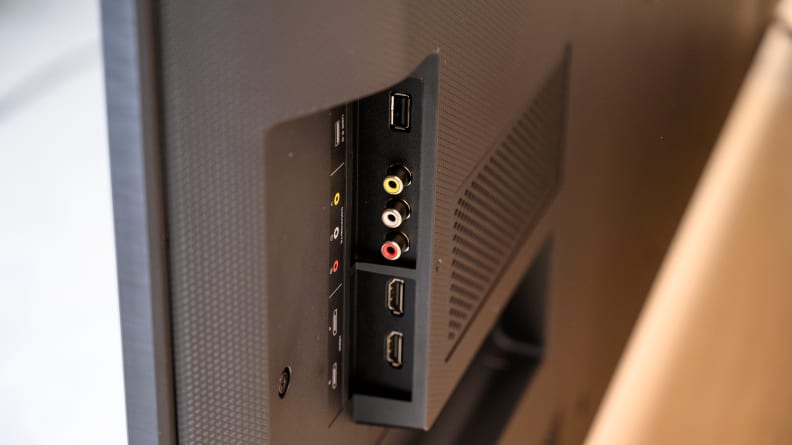
The M-Series Quantum's design isn't terribly interesting, but you're getting four HDMI 2.0 inputs per TV, which is enough for most purposes.
What We Like
It's all about the backlight!
The M-Series Quantum TVs check off a lot of the right boxes where general picture quality is concerned. Obviously, 4K resolution puts them on par with just about any TV worth buying in 2019, but their real strength (and in-fact the strength of Vizio's TVs in general) comes from their full-array local dimming backlights.
So-called "FALD" backlights do a much better job producing a picture than the more common perimeter or edge-based backlighting found in most LED/LCD TVs. With a "full-array" backlight, the TV has light-emitting diodes positioned equidistantly behind the entirety of the screen, rather than being positioned at the edges of the screen and using light pathways to send light towards the middle.
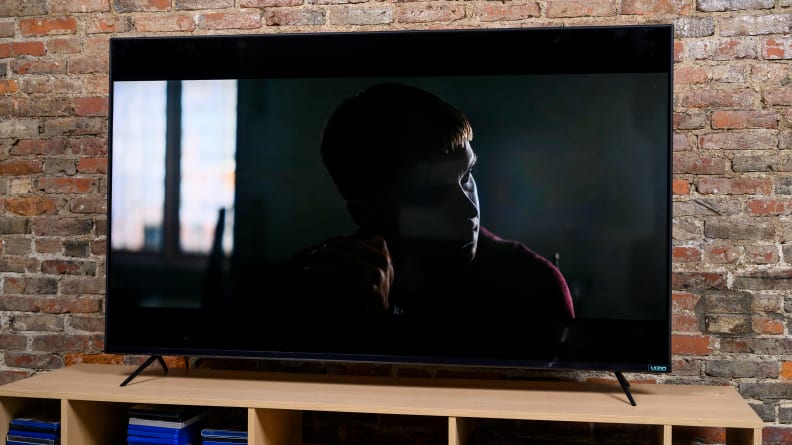
During high contrast scenes like this one, the TV really shines.
To that end, the difference between full-array backlights and edge backlights is night and day. Having more diodes means the TV's can get brighter without introducing "flashlighting," a term referring to when light pollutes areas of the screen meant to be dim or dark. Full-array backlights also allow TVs to get brighter in general, as it stands to reason, you have more lights, so you have more brightness.
One reason full-array backlights fell out of favor for a time was that, without the "local dimming" process, all of the lights behind the screen would have to be set to the same brightness (or lack thereof), making for a picture that lacked contrast within a given scene, even if it could get very bright or dark from scene to scene. So-called local dimming—where individual backlight LEDs can be controlled separately—has become the best way for LED/LCD TVs to get bright enough for HDR content without interrupting shadow uniformity or marring their images with flashlighting effects.
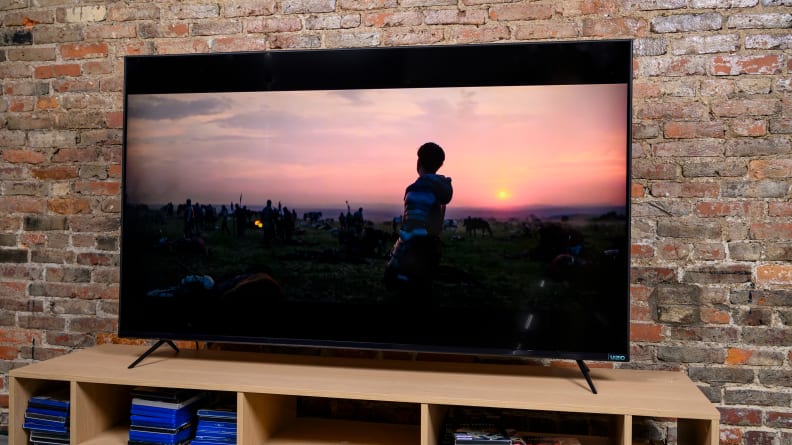
Full-array local dimming is one of the M-Series Quantum's strongest performance features.
However, not all "FALD" TVs are created equally. The basic idea is that you want as many local-dimming zones as possible, but the more zones you have, the more expensive the TV is. One reason the M-Series Quantum TVs are affordable is that, numerically speaking, many of them don't have a lot of zones. The 65-inch M8 we tested in the lab has 90 zones, which is a pretty good amount, but the 50-inch M7 in my apartment only has 16 zones.
This means that, as reviews go, it's hard to say that all of the M-Series Quantum TVs are of the same quality. But overall, their FALD backlights give them a leg up over edge-lit or static full-array backlight TVs.
However, generally, the M-Series Quantum TVs look good. Their VA LCD panels are positioned to offer better contrast than IPS-style panels (at the expense of viewing angle), and even graded at 400 nits, they're very bright. Having upgraded from a 2012 Samsung that used a full-array backlight but did not have local dimming, the difference in contrast has been striking.

In Calibrated or Calibrated Dark picture modes, the M-Series Quantum delivers an overall very good picture, plenty bright and colorful with no real drawbacks.
I've spent several weeks watching the 50-inch M7, and have been really impressed with it. My fiancée and I re-watched the entirety of Game of Thrones (and yes, season 8 is still a letdown), and almost every scene looked better from a contrast perspective. Shadows were darker, and light sources (especially bright sun filtering in through windows) looked really amazing at times.
To TV diehards, the M-Series Quantum's offering of either 400 or 600 nits of brightness might not sound that impressive. We've seen TVs in the last couple of years that could hit upwards of 2,000 nits, and even dimmer OLED TVs can hit around 700 or 800 nits. However, if you're upgrading a non-HDR TV (or one that's 6+ years old, like mine was), you're definitely going to notice the difference.
The average non-HDR TV can hit around 300 nits, but even then, you're not getting that all the time. Pushed to maximum Backlight and Contrast settings, some older TVs might come close to the M7's 400 nit rating, but the difference is that those older TVs are clipping details and washing out highlight sections in order to hit those numbers. They're over-exerting their abilities, whereas the 400-nit Quantum sits comfortably in that range, sometimes straying higher. The difference from scene-to-scene is very noticeable, and that's without even considering color quality.
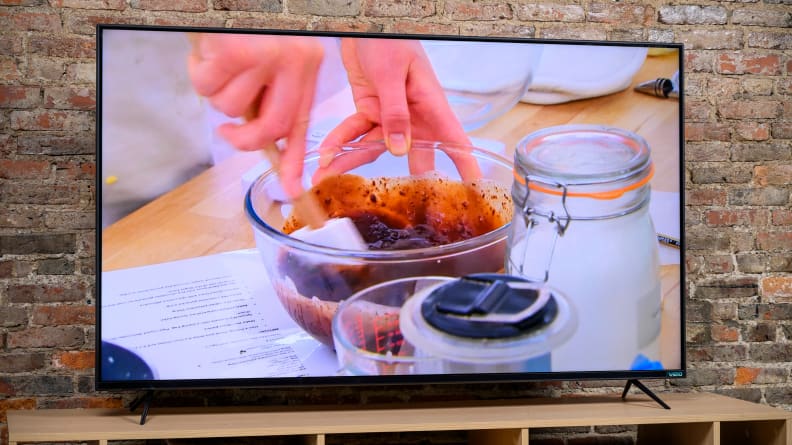
Whether you get a 400 nit or 600 nit M-Series Quantum it's going to be plenty bright, unless your room has a ton of ambient lighting or window glare.
In our lab, the 65-inch M8 tended to sit closer to 250 nits during non-HDR testing, and around 530 during HDR in the "Calibrated" picture mode. While I'm sure it could hit 600 nits (or more) in the Vivid/Dynamic picture mode, 250-400 nits during general performance and specular highlights of 500-600 is plenty of brightness, especially if you're watching in a dimmer or dark room. Even after a few weeks watching the 400-nit M7, I still find myself wincing sometimes when it transitions from a darker to a brighter scene.
As zone count goes, the 65-inch M8's 90 zones are enough for its size. Could it benefit from more? Certainly. But for what you're paying, the amount of zone-count related flaws are very minimal. You may occasionally see zones activating or dimming incorrectly, but 90 gives you enough granularity between areas of the screen that there's not much to worry about by way of crushed shadow details or highlights that aren't rendered properly, especially if you're using the Calibrated or Calibrated Dark mode.
As is usually the case with the M-Series, there's some notable differences in black level quality depending on how much of the screen is bright/dark. Larger shadow clusters, where lots of the diodes can dim down or shut off, will give you very impressive darkness (we measured 0.002 nits in the lab), but when less of the screen is dark, it'll be quite a bit brighter (we measured 0.058). However, you're unlikely to notice the discrepancy because of how your eyes work. When most of the screen is bright, your eyes can't resolve shadows darker than a certain cutoff.
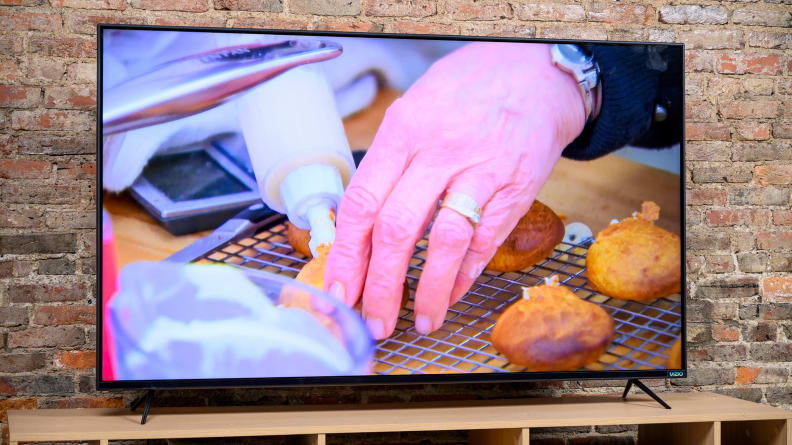
Because it's a 4K TV, sub-1080p content isn't always perfectly scaled, but for the most part the M-Series Quantum does as good a job as the competition in this regard.
Where this gets a bit trickier is with the M7 TVs, with less zones. I have rarely noticed huge scene-to-scene issues with my 50-inch M7's peak brightness or shadow levels. Certainly, it never looks imbalanced within a particular scene. However, there's a dynamic quality to the way its backlight functions (with only having 16 zones) where darker scenes have a lower median brightness and brighter scenes have a higher median brightness. It doesn't bother me while I'm watching, but I suspect the back and forth of general brightness across a single piece of content is more tiring for my eyes than a TV that maintains a more static backlight level. However, it's worth it for the contrast!
The lower zone count also results in more noticeable zone-related picture flaws than a FALD TV with a higher zone count. Like, while an app is loading and the loading circle is rotating in the center of the screen, I can see the central zones dimming and brightening as it moves through them. But after hours and hours of content—including TV shows, movies, and video games—I haven't ever noticed trailing or slow-activating zones while actually watching something.
Vizio has been working on improving its TVs' local dimming algorithm for years now, and it shows, especially in the lower-zone-count M-Series Quantum TVs where you'd expect more discrepancies. The real takeaway is that, unless you're upgrading from a TV that was already fairly premium when you bought it, even the lower zone, lower brightness M-Series Quantum TVs are going to look pretty darn good, and improve even older non-HDR content.
Quantum dots make everything better
Most advances in TV technology come with pros and cons. For example, while 4K resolution is definitely a step forward, it makes watching pre-1080p content risky sometimes. I've mostly watched 1080p content on my 50-inch M7, and it upscales fine, but I started playing a video game from 2009 the other day, and the scaling sometimes introduces aberrations that wouldn't be there on a native 1080p TV.
However, quantum dots are one technology that don't seem to have any drawback: these nano-crystals greatly improve the color saturation in reds and greens, allowing TVs to get brighter and more granular (both in general and for HDR/Dolby Vision purposes) without washing out colors.
Quantum dot color was LED/LCD tech's first step towards competing with the naturally more saturated appearance of OLED televisions, and for the most part, getting a TV with quantum dots has meant paying a premium. One of the best things about the M-Series Quantum is that you get quantum dots at prices that are still reasonable.
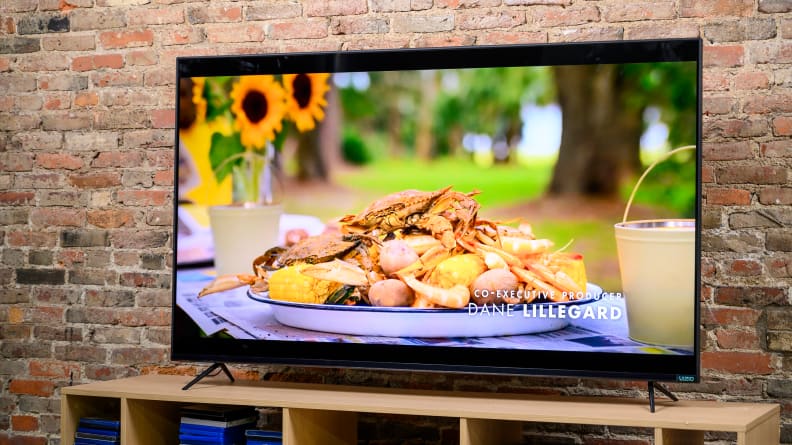
The M-Series Quantum uses quantum dots, a TV technology that greatly increase a TV's color saturation capabilities.
For example, I got the 50-inch M7 while it was on sale at Target for less than $400, and I was psyched to be able to get a TV with quantum dots for so cheap. The difference in color saturation wasn't flabbergasting, but I noticed it right away. I'd been playing Skyrim on my Xbox One S (which does 4K, but not HDR), and even a game that was 8 years old was bolstered, however slightly, by the new TV's quantum dots. Especially brighter, red/orange objects like held torches took on a new life. Likewise, the "Red Lady" in Game of Thrones looked altogether more red and vivid than she had on my old TV.
Quantum dots don't make every element of the TV more colorful, but they do add a certain amount of runway to color saturation that, on top of making more richly saturated colors stand out, helps with subtler elements of color gradation and shading.
In the lab, the 65-inch M8's quantum dots helped it nail our basic non-HDR color test (it was 97% accurate), and it can also fill the new HDR color space (sometimes called 'P3') easily, producing a more saturated red and much more saturated green. While even in Calibrated mode the 65-inch M8's color production isn't perfect (white is a bit blue-ish, red is a bit orange-ish, and green is actually too saturated), a skilled calibrator could even these errors out without much trouble.
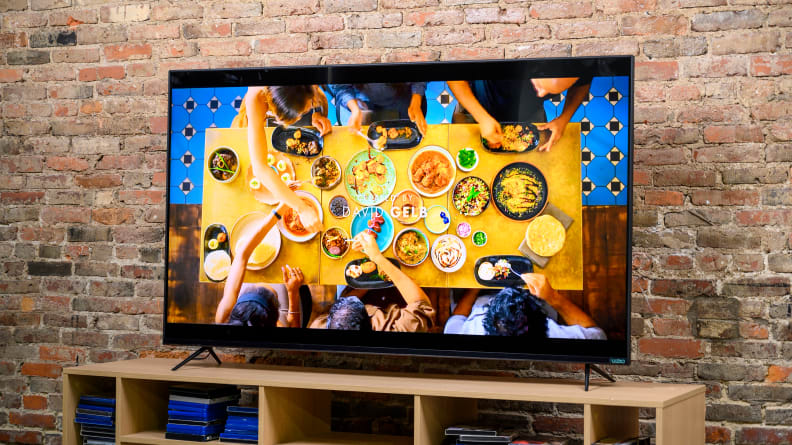
The M-Series Quantum easily produces all of the non-HDR color spectrum, and covers the wider HDR color space as well.
The takeaway is that the M-Series Quantum TVs all offer excellent color accuracy out of the box, and really awesome color saturation regardless of HDR, especially for what you're paying. Even while watching content that's not that colorful, most viewers will probably notice better saturation overall, especially in dimmer scenes where many TVs struggle to bring out color saturation while using less light. For example, the purple coloration of the Joker's coat in The Dark Knight may look almost colorless and gray on many older TVs, but on the new quantum dot-equipped M-Series TVs, you'll be able to make out a shadowy violet that likely wasn't visible on your old TV.
I also watched The Long Night (for the first time) streaming via the Hulu plus HBO configuration, and it was absolutely awesome. I didn't calibrate my 50-inch M7, just put it in Calibrated Dark mode and made adjustments for my living room, and neither my fiancée or I had any problems seeing everything that was going on. While they've definitely improved the encoding for that episode since it first aired live, it's still a very tricky thing to render properly. It's great to be able to get such nuanced playback on such an affordable TV.
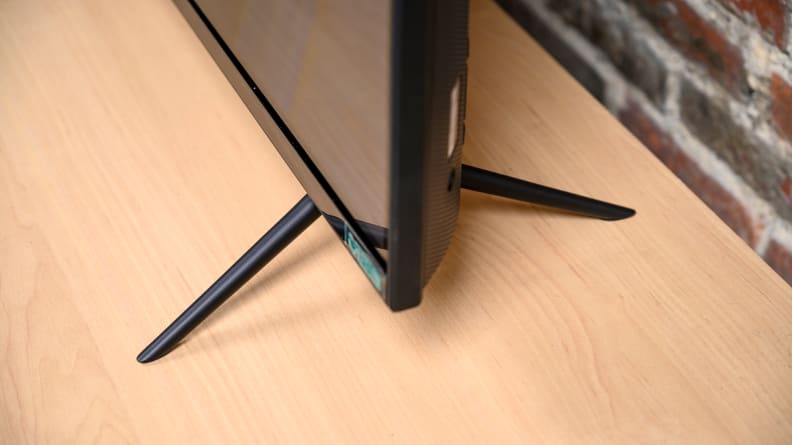
Like most of Vizio's 2019 lineup, the M-Series Quantum has very wide-set feet, so make sure you measure your TV stand before you buy.
While playing bright, more saturated games like Overwatch or Forza Horizon 4, the enhanced color is going to do wonders, especially if you've got one of the more high-end video game consoles. Sports jerseys and the green fields in football or soccer get souped up too—in fact, many of your favorite teams' actual colors won't have been displaying properly on older TVs, but teams with highly saturated red or orange may actually be represented properly for the first time on a quantum dot TV like the M-Series Quantum. These kinds of details are what make it so awesome that Vizio's offering such an affordable quantum dot model this year.
A bunch of elements are, well, good enough
As I stated once already, the M-Series Quantum's strengths lie solely in its picture quality. Regardless of model, you're getting good brightness, solid contrast, a fluidly functioning backlight, good screen uniformity, great color saturation/color detail, 4K resolution that upscales without artifacts, and enough HDMI inputs (four of them) that all but the most advanced living room or home theater setups won't struggle to get everything connected.
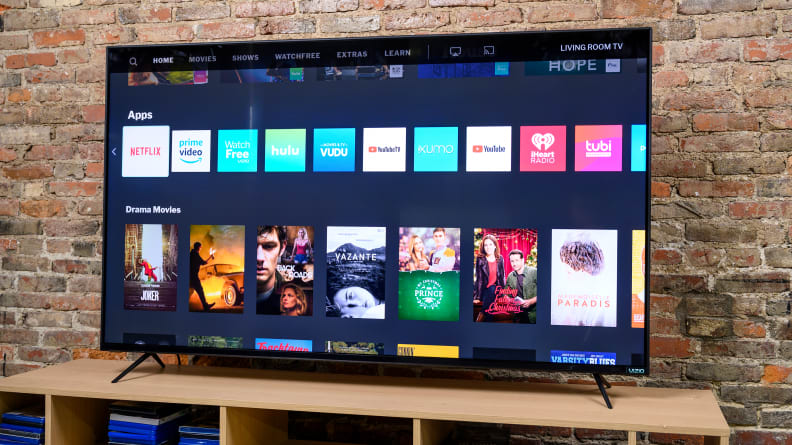
The Vizio SmartCast 3.0 platform isn't going to replace your media streaming box, but it works well enough for what you're paying here.
However, many of the lesser details, while not "bad," are only good enough, and that's why you're saving money. The remote is small and cheap-feeling (I don't mind it, but my 2012 Samsung's remote was nicer); the TV's wide-set caltrop feet and narrow bezels wrap a panel that's essentially just milquetoast black plastic; audio is entirely average, and I recommend folks look into pairing their TV with a soundbar most of the time; and the smart platform works fine, but we vastly prefer the Roku platforms on TCL's similarly priced TVs.
Something worth talking about is that all of the M-Series Quantum TVs have 60 Hz refresh rates, rather than 120 Hz refresh rates. Both the 65-inch M8 and 50-inch M7 are equipped with Vizio's usual suite of motion-enhancing tools (the smoothing effect that can lead to the 'soap opera effect'). That said, while using the 50-inch M7, I haven't had any qualms about motion. I'm not as sensitive to this as some folks, but video games seem to be free of input lag issues, content is judder-less, and there isn't much by way of blurring or color trailing to speak of.
I've been viewing most content with Game mode on, and haven't ever had anything look too wonky. Every now and again, difficult camera pans look a little funny. I remember once scene in Game of Thrones where the background had lit torches drifting behind characters as the camera swung around them, and watching the torches skip subtly past foreground characters made me feel a little dizzy, but 95% of the time, TV/movie/game motion looks good.
I've also been playing Gears 5 since that game launched. As a veteran player, I'm very comfortable with the series' general pacing and mechanics, and was able to jump into multiplayer and outplay plenty of likely younger, spryer folks. When I lost, I never felt like the TV's motion or lag was to blame at all. As a bonus, the 50-inch M7's brightness and quantum color make that game in particular look incredible, especially during the single-player campaign.
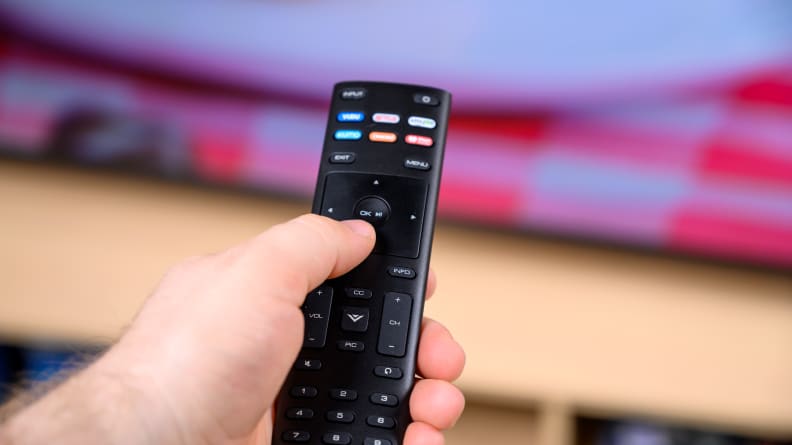
The included remote has gotten some complaints for being smaller/cheaper-feeling that people prefer, but it gets the job done.
Using an Xbox for most of my media needs, I generally don't touch the SmartCast platform, and I haven't missed it. My fiancée uses it when she's watching TV without me so she doesn't have to worry about all the steps between turning on an Xbox and launching Netflix, and she's got no complaints, but if given the choice I always use the Xbox over the SmartCast platform. That's not to mention the TV's built-in Hulu app has had some audio leveling issues, and we had to turn on an audio delay fixer while watching HBO.
All that is to say, if you spring for any of the M-Series Quantum TVs, don't expect to be blown away by posh design details. You might hate the remote, if you're picky about that kind of thing. I'd recommend—if you really want the smoothest experience—to use either a game console like the Xbox/PS4 or a Roku/Apple TV with the Quantum TVs, and a soundbar for audio.
What We Don't Like
Don't expect a 100% flawless user experience
You know going in that you're buying a more affordable TV, but it stands that your money is going towards the real meat and potatoes stuff: 4K resolution, HDR/Dolby Vision/HLG compatibility, a full-array backlight, and so on. The package that nets you all this picture quality goodness is a bit on the cheaper side, but that's the point.
For example, I upgraded from a 50-inch 2012 Samsung to a 50-inch 2019 Vizio, and paid less than half of what I paid for the Samsung, so I knew there'd be some wonkyness to contend with. The remote can be slow, and more than once the screen has very momentarily turned off/lost the HDMI signal from my Xbox for no apparent reason. Using the TV is very smooth 90% of the time, but there's a certain sluggishness to it at times that I sometimes worry will just grow worse over the years.
Also, at one point the screen simply went black. I heard audio, but had no picture. I ended up having to totally unplug it and wait a few minutes to get things working again. I'm not doubting the overall reliability, but I wasn't surprised when I had to deal with something like that. It's the price I'm paying for getting a 50-inch 4K/HDR quantum dot smart TV for $380.
One of the things you're usually paying for with pricier TVs (other quantum dot options, from companies like Samsung and Sony, which will easily charge you almost twice as much as Vizio does here) is better processing and more overall TV memory. If you're looking for a TV that's stuffed full of advanced options and allows you to download oodles of apps and games and stay zippy for a long time, you're not going to get that with any of the M-Series Quantum TVs. You're still getting a usable smart platform, but continually adding things to it will slow it down pretty quickly.
However, if you aren't a smart platform power user and have other ways of accessing apps and the like, you'll be fine mostly ignoring the SmartCast platform. It isn't bad, but it's not going to replace your usual devices any time soon.
No option for a 120 Hz variant
It stands to reason that, as 2019 TV series go, the M-Series Quantum TVs are in a great position to steal the award for "Best Value" from TCL's beloved 6 Series. Both are priced very affordably, offering 4K/HDR in ranges most people can afford, and delivering similar levels of brightness and overall contrast performance.
However, one major difference between them is that, while TCL's 6-Series TVs offer the advantage of a 120 Hz refresh rate, all of the M-Series Quantum TVs are 60 Hz only. The difference here is simple math: 120 Hz TVs refresh 120 times a second, while 60 Hz TVs refresh 60 times a second.
As I said, I haven't had any problems with things like motion blur, input lag, color trailing, or film (24 fps) playback on my 50-inch M7, but more sensitive viewers might. If you like to watch lots of sports and are sensitive to motion, or plan on playing video games where split-second timing, you should at least be aware that you're not getting the best possible motion here. If you like to watch 24fps playback content (i.e. most Blu-rays and non-streaming movies), you may notice
For most people, 60 Hz is totally fine, but for sensitive viewers (especially if you know that your previous TV was a 120 Hz model), you might want to consider upgrading from the Vizio M-Series Quantum to the Vizio P-Series.
Viewing angles that just barely get by
We have a lab test for measuring viewing angle, but I didn't need Michael to run it to figure out that the horizontal (side to side) viewing angle on the M-Series Quantum TVs isn't great.
As it stands, LED/LCD TVs that use VA style panels (like these) don't usually have viewing angles on par with IPS panels. The literal alignment of the panel (vertical) has everything to do with how the liquid crystal substance operates. Vertically aligned, it produces better black levels (and thus better contrast) by not allowing as much light through. However, this also means less light is communicated laterally (to either side), which is one reason the picture quality will start to lose contrast as you move away from watching it head-on.
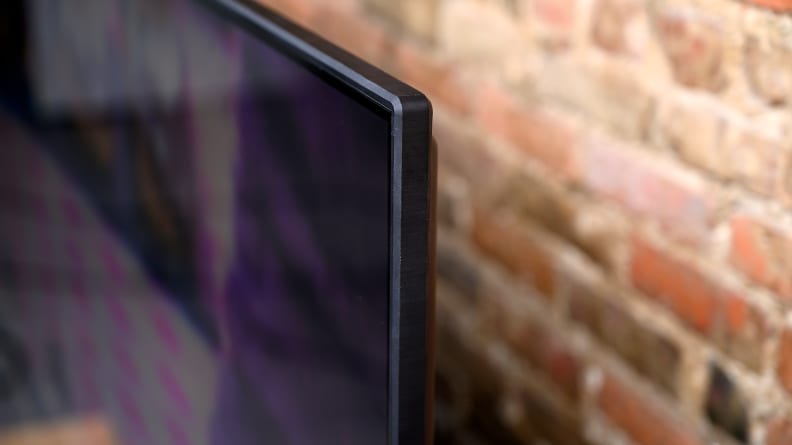
Because they're VA-paneled TVs and are capable of such color saturation, off-angle viewing can be risky, with contrast falling off and color shifting fairly quickly as you move away from center.
Couple this functionality with the addition of quantum dots—which spike particular colors into higher saturation, but use high brightness backlights in order to reach them—and you end up with not just worse contrast at off angles, but more color shifting overall. This means that, at wider off-angles, brightness drops, shadows start to look gray, and highly saturated reds start to look orange, among other things.
The viewing angles aren't terrible, but if you're buying one of the large Quantums (65 or 70 inches), you'll want to be very careful about how you place it in the room, especially if you're thinking of wall mounting it.
Not bright enough for some rooms
The M-Series Quantum definitely has the color to produce really jaw-dropping HDR visuals, but whether you buy one of the 400 or 600 nit versions, you're not getting as much sheer brightness as some of the competition. Granted, even the 400-nit M-Series Quantum is probably brighter than the TV you're upgrading (most non-HDR TVs only get around 250/300 nits of brightness).
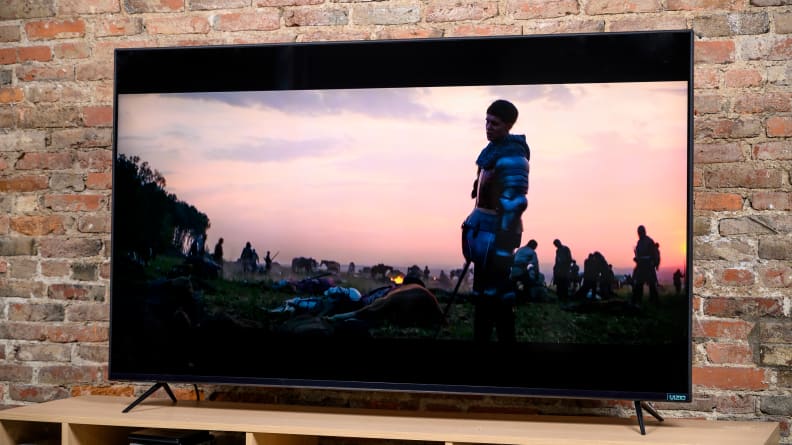
Depending on your room, you may find the M-Series Quantum—especially the 400 nit variant—to be not bright enough for your room lighting.
While the added color goes a long way for making HDR (and everything else) look pretty darn good on these TVs, the brightness is limited just enough that I wouldn't recommend them for viewers with a living room full of lamps or bright windows.
Our lab is dark, while my apartment is notably dim, and the 400/600 nit M7/M8 Quantum TVs were easily bright enough for those environments, but I can tell that my M7 might look a little washed out if I had it in a room with lots of ambient lighting.
Should You Buy It?
Yes—if you don't need 120 Hz or watch in a bright room
At this point, you should know what you're getting here. The M-Series Quantum isn't the brightest TV in its price range, but it's a heck of a lot brighter than the TV you're likely replacing, and the addition of quantum dots put it head-and-shoulders—color-wise, anyway—above most 2019 sets going for less than $1,500.
If you aren't concerned about eking out next-level 4K/HDR performance and shopping between the year's heavy-hitter value picks, I still recommend this TV as a general upgrade piece. You're getting 4K, all the HDR compatibility you could need, and vivid quantum dot color at a super reasonable price. The M-Series Quantum is the one of the only ways to get premium quantum dot performance without spending a ton of money, and Vizio deserves kudos for clearing the way.
I can't do a full comparison between the M-Series Quantum and the recently announced 2019 TCL 6-Series (which adds quantum dots) yet, but I can say that what the M-Series has going for it is flexibility. Starting at 43 inches and running the gamut up to 70 inches, it's available in a wider variety of sizes than its TCL competition.
Vizio has spent more time refining its full-array dimming algorithm, so in sub-65-inch sizes I'm inclined to expect the Quantums to perform better even if they're not as bright as some of the competition. Unless you prefer very high brightness over a more refined performance—or you just really need a 120 Hz TV—the M-Series Quantum is the best you're going to do in this price range.
Meet the testers
Lee was Reviewed's point person for most television and home theater products from 2012 until early 2022. Lee received Level II certification in TV calibration from the Imaging Science Foundation in 2013. As Editor of the Home Theater vertical, Lee oversaw reviews of TVs, monitors, soundbars, and Bluetooth speakers. He also reviewed headphones, and has a background in music performance.
Michael Desjardin graduated from Emerson College after having studied media production and screenwriting. He specializes in tech for Reviewed, but also loves film criticism, weird ambient music, cooking, and food in general.
Checking our work.
Our team is here to help you buy the best stuff and love what you own. Our writers, editors, and experts obsess over the products we cover to make sure you're confident and satisfied. Have a different opinion about something we recommend? Email us and we'll compare notes.
Shoot us an email
